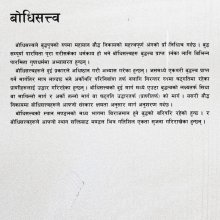Sampurna, Sampūrṇa, Saṃpūrṇa, Sampūrṇā, Saṃpūrṇā: 20 definitions
Introduction:
Sampurna means something in Buddhism, Pali, Hinduism, Sanskrit, Jainism, Prakrit, Marathi, Hindi. If you want to know the exact meaning, history, etymology or English translation of this term then check out the descriptions on this page. Add your comment or reference to a book if you want to contribute to this summary article.
Alternative spellings of this word include Sampurn.
Images (photo gallery)
In Hinduism
Shaktism (Shakta philosophy)
Source: Google Books: ManthanabhairavatantramSaṃpūrṇā (संपूर्णा) refers to “she who is completely full”, according to the Manthānabhairavatantra, a vast sprawling work that belongs to a corpus of Tantric texts concerned with the worship of the goddess Kubjikā.—Accordingly, “[...] Within the Sky-farer is the Mistress of the Sky-farer (Khageśvarī). She is the sky-faring of the Sky-farers. (She is) Kaulinī who, beyond the Void, is established in the Void. (The goddess continued): I (the goddess) am the (energy of Unstruck Sound called) the Female Gander of the Void (khahaṃsā), present in the Gander (of Unstruck Sound) and residing in the Void: I am the supreme energy in the world of transmigration. I am the Void and I have six parts. Completely full [i.e., saṃpūrṇā] I am the Full Moon. In the middle of the lunar orb, beyond destruction (kṣara), (I am) Kaulinī (the New Moon). [...]”.

Shakta (शाक्त, śākta) or Shaktism (śāktism) represents a tradition of Hinduism where the Goddess (Devi) is revered and worshipped. Shakta literature includes a range of scriptures, including various Agamas and Tantras, although its roots may be traced back to the Vedas.
Jyotisha (astronomy and astrology)
Source: Wisdom Library: Brihat Samhita by VarahamihiraSampūrṇa (सम्पूर्ण) refers to a “full moon”, according to the Bṛhatsaṃhitā (chapter 4), an encyclopedic Sanskrit work written by Varāhamihira mainly focusing on the science of ancient Indian astronomy astronomy (Jyotiṣa).—Accordingly, “If the two horns of the moon should appear but slightly raised and far from each other presenting the appearance of a boat, she brings trouble on the sailors but prosperity on mankind at large. [...] If, to any person who observes on the first lunar day after new-moon, the moon should appear of only one horn, or if one of the horns should appear bent downwards or if she appear like a full moon [i.e., sampūrṇa] (when in reality such is not the case) the person dies”.

Jyotisha (ज्योतिष, jyotiṣa or jyotish) refers to ‘astronomy’ or “Vedic astrology” and represents the fifth of the six Vedangas (additional sciences to be studied along with the Vedas). Jyotisha concerns itself with the study and prediction of the movements of celestial bodies, in order to calculate the auspicious time for rituals and ceremonies.
Yoga (school of philosophy)
Source: Brill: Śaivism and the Tantric Traditions (yoga)Saṃpūrṇa (संपूर्ण) refers to the “(being) complete”, according to the Amṛtasiddhi, a 12th-century text belonging to the Haṭhayoga textual tradition.—Accordingly, “The sphere of the sun is at the base of the Central Channel, complete (saṃpūrṇa) with twelve digits, shining with its rays. The lord of creatures (Prajāpati), of intense appearance, travels upwards on the right. Staying in the pathways in the spaces in the channels it pervades the entire body. The sun consumes the lunar secretion, wanders in the sphere of the wind and burns up all the bodily constituents in all bodies”.

Yoga is originally considered a branch of Hindu philosophy (astika), but both ancient and modern Yoga combine the physical, mental and spiritual. Yoga teaches various physical techniques also known as āsanas (postures), used for various purposes (eg., meditation, contemplation, relaxation).
Shaivism (Shaiva philosophy)
Source: SOAS University of London: Protective Rites in the Netra TantraSampūrṇa (सम्पूर्ण) refers to a “full (moon)”, according to the Svacchanda-tantra.—Accordingly, [verse 7.216cd-217, while describing the meditation on the kālahaṃsa]—“After [this, the Yogin] visualizes the heart lotus, with sixteen petals, situated in the opening of the channel that pierces the tube [i.e., the lotus stem. He imagines] a white, radiant, completely full moon (sampūrṇa—sampūrṇāvayavaṃ candraṃ), endowed with sixteen parts, and with his body in the shape of a lotus pericarp. [Then, he pictures] the self, It is to be imagined [as seated] in the middle of that [moon], and is as spotless as pure crystal. [The self is] pervaded with amṛta, [which washes over him] in a wave from the ocean of the milky nectar of immortality”.

Shaiva (शैव, śaiva) or Shaivism (śaivism) represents a tradition of Hinduism worshiping Shiva as the supreme being. Closely related to Shaktism, Shaiva literature includes a range of scriptures, including Tantras, while the root of this tradition may be traced back to the ancient Vedas.
Ganapatya (worship of Ganesha)
Source: archive.org: Shiva Purana - (Ganesha)Saṃpūrṇa (संपूर्ण) refers to “having completed” (the Vrata or worship of Gaṇeśa), according to the Śivapurāṇa 2.4.18 (“Gaṇeśa crowned as the chief of Gaṇas”).—Accordingly, as Śiva said to Gaṇeśa: “[...] Then the rites shall formally be dismissed. Then he shall remember Gaṇeśa. Thus the Vrata shall be concluded auspiciously. When thus the Vrata is duly completed (saṃpūrṇa) in a year, the devotee shall perform the rite of formal dismissal for the completion of the Vrata. At my bidding twelve brahmins shall be fed. After placing a jar your image shall be worshipped. [...]”.
Ganapatya (गाणपत्य, gāṇapatya) represents a tradition of Hinduism where Ganesha is revered and worshipped as the prime deity (ishta-devata). Being a minor though influential movement, Ganapatya evovled, llike Shaktism and Shaivism, as a separate movement leaving behind a large body of literature.
Purana and Itihasa (epic history)
Source: archive.org: Shiva Purana - English TranslationSaṃpūrṇa (संपूर्ण) refers to “complete (rites)”, according to the Śivapurāṇa 2.5.3 (“The virtues of the three cities—Tripura).—Accordingly, after Viṣṇu spoke to the Gods: “On hearing the words of Viṣṇu, the intelligent lord of the gods and bowing to him lovingly, the gods eulogised the lord of sacrifices. O sage, eulogising thus, the gods worshipped the Sacrificial Being in accordance with the rules governing the same with the complete rites (saṃpūrṇa-vidhi) [yajñoktena vidhānena saṃpūrṇavidhayo]. Then from the sacrificial pit rose up thousands of Bhūtas of huge size and armed with tridents, spears, iron clubs and other weapons. [...]”.

The Purana (पुराण, purāṇas) refers to Sanskrit literature preserving ancient India’s vast cultural history, including historical legends, religious ceremonies, various arts and sciences. The eighteen mahapuranas total over 400,000 shlokas (metrical couplets) and date to at least several centuries BCE.
In Buddhism
Tibetan Buddhism (Vajrayana or tantric Buddhism)
Source: Wisdom Library: Tibetan BuddhismSaṃpūrṇa (संपूर्ण) is the name of a Śrāvaka mentioned as attending the teachings in the 6th century Mañjuśrīmūlakalpa: one of the largest Kriyā Tantras devoted to Mañjuśrī (the Bodhisattva of wisdom) representing an encyclopedia of knowledge primarily concerned with ritualistic elements in Buddhism. The teachings in this text originate from Mañjuśrī and were taught to and by Buddha Śākyamuni in the presence of a large audience (including Saṃpūrṇa).

Tibetan Buddhism includes schools such as Nyingma, Kadampa, Kagyu and Gelug. Their primary canon of literature is divided in two broad categories: The Kangyur, which consists of Buddha’s words, and the Tengyur, which includes commentaries from various sources. Esotericism and tantra techniques (vajrayāna) are collected indepently.
In Jainism
General definition (in Jainism)
Source: The University of Sydney: A study of the Twelve ReflectionsSaṃpūrṇa (संपूर्ण) refers to “whole (fruit)”, according to the 11th century Jñānārṇava, a treatise on Jain Yoga in roughly 2200 Sanskrit verses composed by Śubhacandra.—Accordingly, “Glory to the great tree that is stopping the influx of karma whose opponent is conquered, which is rooted in all the rules of conduct for a mendicant, whose great trunk is restraint, whose full branches are tranquillity, which is covered with the blossom of virtue [and] is beautiful because of producing whole fruit through the reflections [com.—beautiful (manoharaḥ) because of producing whole fruit (saṃpūrṇaphalabandhaiḥ)]. [Thus ends the reflection on] stopping the influx of karma”.
Synonyms: Avikala.

Jainism is an Indian religion of Dharma whose doctrine revolves around harmlessness (ahimsa) towards every living being. The two major branches (Digambara and Svetambara) of Jainism stimulate self-control (or, shramana, ‘self-reliance’) and spiritual development through a path of peace for the soul to progess to the ultimate goal.
Languages of India and abroad
Marathi-English dictionary
Source: DDSA: The Molesworth Marathi and English Dictionarysampūrṇa (संपूर्ण).—a (S) All, every one, the whole. 2 Whole, entire, complete, perfect. 3 p Completed, perfected, finished, prepared or executed wholly. 4 as s n The entertainment of Brahmans, or other particular ceremony, completing and closing a religious observance.
Source: DDSA: The Aryabhusan school dictionary, Marathi-Englishsampūrṇa (संपूर्ण).—a All; whole. p Completed.
Marathi is an Indo-European language having over 70 million native speakers people in (predominantly) Maharashtra India. Marathi, like many other Indo-Aryan languages, evolved from early forms of Prakrit, which itself is a subset of Sanskrit, one of the most ancient languages of the world.
Sanskrit dictionary
Source: DDSA: The practical Sanskrit-English dictionarySaṃpūrṇa (संपूर्ण).—a.
1) Filled &c.
2) All, whole; see पूर्ण (pūrṇa).
Source: Cologne Digital Sanskrit Dictionaries: Edgerton Buddhist Hybrid Sanskrit DictionarySaṃpūrṇa (संपूर्ण) or Pūrṇa.—(1) 1, name of a disciple of Śākyamuni: Avadāna-śataka i.2.2 (here ms. Sa-p°); 3.1; (2) name of a Buddha (possibly = Pūrṇa 5): (Ārya-)Mañjuśrīmūlakalpa 499.23 (verse).
Source: Cologne Digital Sanskrit Dictionaries: Shabda-Sagara Sanskrit-English DictionarySampūrṇa (सम्पूर्ण).—mfn.
(-rṇaḥ-rṇā-rṇaṃ) 1. Whole, entire. 2. Complete, finished. m.
(-rṇaḥ) Any mode of music in which all the notes of the gamut are employed. n.
(-rṇaṃ) Ether, the etherial matter or atmosphere. E. sam intensitive, and pūr to fill, kta aff.
Source: Cologne Digital Sanskrit Dictionaries: Cappeller Sanskrit-English DictionarySaṃpūrṇa (संपूर्ण).—[adjective] full, replete, filled or richly furnished with ([instrumental], [genetive], or —°); whole, entire, abundant; finished, accomplished.
Source: Cologne Digital Sanskrit Dictionaries: Monier-Williams Sanskrit-English Dictionary1) Sampūrṇa (सम्पूर्ण):—[=sam-pūrṇa] [from sam-pṝ] mfn. completely filled or full (also said of the moon), full of, completely endowed or furnished with ([instrumental case], [genitive case], or [compound]), [Mahābhārata; Kāvya literature] etc.
2) [v.s. ...] complete (also in number), whole, entire, [Manu-smṛti; Mahābhārata] etc.
3) [v.s. ...] abundant, excessive, [Bhartṛhari]
4) [v.s. ...] possessed of plenty, [Śārṅgadhara-paddhati]
5) [v.s. ...] fulfilled, accomplished, [Mṛcchakaṭikā; Śakuntalā]
6) [v.s. ...] m. (in music) a scale which comprehends all the notes of the gamut, [Horace H. Wilson]
7) [v.s. ...] one of the four wagtails employed for augury, [Varāha-mihira’s Bṛhat-saṃhitā xl, 2]
8) Sampūrṇā (सम्पूर्णा):—[=sam-pūrṇā] [from sam-pūrṇa > sam-pṝ] f. a [particular] Ekādaśī (q.v.)
9) Sampūrṇa (सम्पूर्ण):—[=sam-pūrṇa] [from sam-pṝ] n. ether, the ethereal element or atmosphere, [Horace H. Wilson]
Source: Cologne Digital Sanskrit Dictionaries: Yates Sanskrit-English DictionarySampūrṇa (सम्पूर्ण):—[sa-mpūrṇa] (rṇaḥ-rṇā-rṇaṃ) a. Full, complete, entire. m. A mode of music including the entire gamut. n. Æther, atmosphere.
Source: DDSA: Paia-sadda-mahannavo; a comprehensive Prakrit Hindi dictionary (S)Saṃpūrṇa (संपूर्ण) in the Sanskrit language is related to the Prakrit word: Saṃpuṇṇa.
[Sanskrit to German]
Sanskrit, also spelled संस्कृतम् (saṃskṛtam), is an ancient language of India commonly seen as the grandmother of the Indo-European language family (even English!). Closely allied with Prakrit and Pali, Sanskrit is more exhaustive in both grammar and terms and has the most extensive collection of literature in the world, greatly surpassing its sister-languages Greek and Latin.
Hindi dictionary
Source: DDSA: A practical Hindi-English dictionarySaṃpūrṇa (संपूर्ण) [Also spelled sampurn]:—(a) whole; entire; complete; perfect; finished; total; ~[taḥ/tayā] wholly, entirely; completely; totally; perfectly; ~[tā] entirety, completeness; perfection; —[honā] to be completed/finished; to be perfect.
...
Kannada-English dictionary
Source: Alar: Kannada-English corpusSaṃpūrṇa (ಸಂಪೂರ್ಣ):—
1) [adjective] filled completely with; full.
2) [adjective] complete; entire; whole.
3) [adjective] accomplished; fulfilled.
--- OR ---
Saṃpūrṇa (ಸಂಪೂರ್ಣ):—
1) [noun] the quality or state of being filled completely with.
2) [noun] that which is not lacking any of the parts; a whole.
3) [noun] the end; conclusion.
4) [noun] name of the first of the four mythological ages of the world; křtayuga; golden age.
5) [noun] (mus.) a rāga (musical mode or scale) that comprehends all the notes of the gamut.
--- OR ---
Saṃpūrṇa (ಸಂಪೂರ್ಣ):—[adverb] completely; entirely; wholly.
Kannada is a Dravidian language (as opposed to the Indo-European language family) mainly spoken in the southwestern region of India.
See also (Relevant definitions)
Starts with (+14): Sampurna-garnu, Sampurnacandra, Sampurnakalavantici Khana, Sampurnakalina, Sampurnakama, Sampurnakumbha, Sampurnalakshana, Sampurnam, Sampurnamurccha, Sampurnamurcha, Sampurnamurchchha, Sampurnanga, Sampurnaphala, Sampurnaphalabhaj, Sampurnapuccha, Sampurnapunyamahiman, Sampurnarakam, Sampurnaratna, Sampurnaratnamandala, Sampurnarna.
Ends with: Asampurna, Audavasampurna, Dvigasampurna, Lakshanasampurna, Sangasampurna, Sarvasampurna, Susampurna, Trikasampurna, Vasusampurna, Vratasampurna.
Full-text (+34): Asampurna, Sampuṇṇa, Sampurnakalina, Sampurnata, Sarvamshim, Sampurnam, Vasusampurna, Sampunata, Sampurnasprihata, Susampurna, Gitaprakasha, Sampurnakama, Sangasampurna, Sampurnarakam, Sampurnamurccha, Sampurnarna, Sampurnatayukta, Sampurnavidya, Nyunavacana, Jalapanem.
Relevant text
Search found 33 books and stories containing Sampurna, Sampūrṇa, Saṃpūrṇa, Sampūrṇā, Sampūrṇā, Saṃpūrṇā; (plurals include: Sampurnas, Sampūrṇas, Saṃpūrṇas, Sampūrṇās, Saṃpūrṇās). You can also click to the full overview containing English textual excerpts. Below are direct links for the most relevant articles:
Brihad Bhagavatamrita (commentary) (by Śrī Śrīmad Bhaktivedānta Nārāyana Gosvāmī Mahārāja)
Verse 1.3.73 < [Chapter 3 - Prapañcātīta (beyond the Material Plane)]
Verse 1.6.46 < [Chapter 6 - Priyatama (the most beloved devotees)]
Vakyapadiya of Bhartrihari (by K. A. Subramania Iyer)
Verse 2.272 < [Book 2 - Vākya-kāṇḍa]
Garga Samhita (English) (by Danavir Goswami)
Verse 8.9.3 < [Chapter 9 - Lord Balarāma’s Rāsa Dance]
Sahitya-kaumudi by Baladeva Vidyabhushana (by Gaurapada Dāsa)
Text 10.276 < [Chapter 10 - Ornaments of Meaning]
Text 10.20 < [Chapter 10 - Ornaments of Meaning]
Satirical works of Kshemendra (study) (by Arpana Devi)
5.6. The Oculist (cakṣurvaidya) < [Chapter 5 - Kṣemendra’s objectives of Satire]





